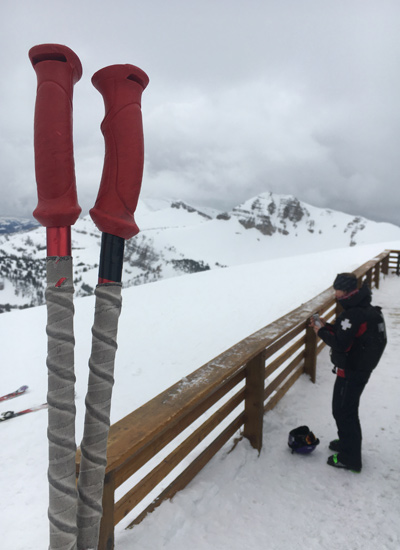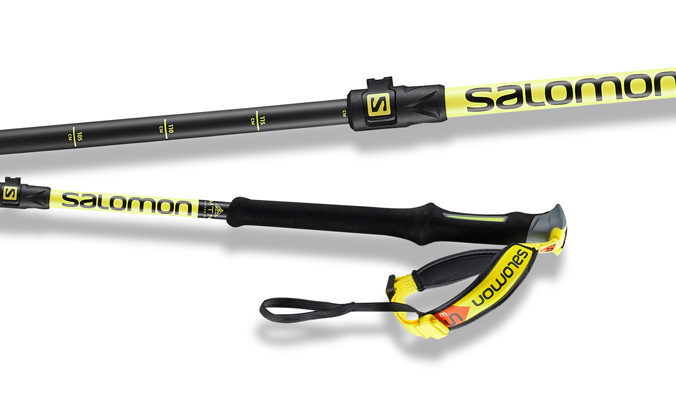
Take it or leave it? The safety of wearing pole straps in the backcountry is debatable. [Photo] skistav
The Dangers
The unassuming poles strap’s notoriety stems from their restrictive nature. Having a hand lashed to a pole can constrain arm movements, limiting self-rescue techniques like swimming to safety, pulling an airbag trigger or digging out. Then there’s the added danger of poles functioning as anchors in a slide, effectively dragging a victim into the depths of cascading debris.
The risks of using pole straps aren’t only limited to avalanche terrain; they can also add to the dangers of falling into a tree well. Acting as restraints, pole straps can impede a tree-well victim’s ability to dig out or create an air pocket while waiting for help. Snow Immersion Suffocation—SIS—is most often responsible for the deaths of skiers and snowboarders when they fall into the area near a tree that is full of unconsolidated snow. This snow pocket functions like quicksand, and as the National Ski Areas Association reports in a SIS factsheet, “The more the person struggles, the more entrapped in the snow he or she may become, and the risk of suffocation increases.” In this SIS report, the NSAA goes on to explain that there were 35 deaths between 2006-2016 due to SIS with an average of 3.5 deaths per year. The NSAA recommends skiing with others to prevent burial and death, but in a link they provide to an SIS information website, deepsnowsafety.org, it is advised that removing pole straps in off-piste terrain is a good prevention strategy to employ.
Secondary injuries can occur when using pole straps in the backcountry, too. Brian Warren, Senior Guide & Winter Director at Jackson Hole Mountain Guides, recounts a friend’s experience skiing low-angle trees in the Tetons. “The track was fast through tight trees,” Warren says. “He had pole straps on, and his baskets got caught in thick alder. The pole stuck immediately and ripped his body to the ground, dislocating his shoulder.”
The Benefits
While some disadvantages of pole straps are undeniable, being leashed to a pole isn’t always a poor choice. Many people cite using their straps as a way to gain extra momentum with every push on long traverses, while others like the support pole straps provide while touring, particularly on slippery skintracks. Others enjoy the safety a strap provides in inclement, windy weather or in no-fall zones, like steep couloirs or exposed ridgelines, where losing a pole increases the danger of falling.
So when is the best time to strap up? AMGA guide Donny Roth says, “About half the time I’m glad I have them and the other half I wish I didn’t. I keep them on my poles, because I use them while skating on the flats or, in some situations, on steep terrain, and it’s easy not to use them if they are there. But most of the time they aren’t really needed and can be dangerous.”
So bring ’em along, but it might be wise to let them flap in the wind until you need a little extra security during your springtime couloir descents.
Pole Strap Hacks:
- Poles like the Black Crows’ Oxus, Duos and Furtis have elongated grips that provide more leverage and better traction in sidehilling and steep skiing scenarios for those who choose to ski sans strap.

The Black Crows Oxus with elongated grips.
- You can create your own elongated grip—adding traction and warmth—by affixing Voilé straps just under the grip of your pole or using bike handlebar tape.

Modified poles with added grip and no straps. [Photo] Peter Popinchalk
- Ski guide Christina Lustenberger declares, “Absolutely no pole straps in the backcountry! I take ’em off right away. All my ski poles are without straps.” Most poles have a screw on the top that secures the strap webbing. Simply unscrew to remove. If that fails, scissors won’t.
- Black Diamond implements what they call SwitchRelease technology. The top of the pole strap releases with upward pressure. Other companies, including Leki, Salomon and Black Crows, are catching on and using a similar technology.

A flip of the wrist releases you from the Salomon MTN pole.










If y’all are looking for a copy editor, I know the difference between “illicit” and “elicit.” Let me know.
On for the climb, off for the descent. It;s really that simple.
You guys love to mention amga guides, too bad most of them only recently started skiing, and almost all are from back east. Not much of a recommendation.
Hi, Jamie. I’m the AMGA-certified Ski Guide mentioned in the article. I did grow up in the East! I started skiing when I was two – that was 1977. I ski raced full-time until college, then taught skiing and coached. In 2004 I started chasing winter to the southern hemisphere where I was a ski instructor and heli-guide. There were a few years when I skied 275-days a year. I still go to Chile each year and this will be my 27th consecutive winter without a full summer, but I admit, I’m getting lazier, now I only ski like 125-days a year in the backcountry. Even with all that, I still look up to and admire hardcore skiers – like you! Keep getting after it.
What about using some old school sabre grip ski poles? Wouldn’t that be the best of both worlds?
The sabre grip unfortunately puts the thumb in a vulnerable position when a skier falls and instinctively puts their hands out to break the fall. Thumb injuries caused this style of grip to fall out of favor in the 80’s. The newer sabre grips are only somewhat better. Also, the sabre grips do not support the wrist and hand during touring and XC like a traditional strap grip used properly.
http://www.skiingforever.com/skiers-thumb/